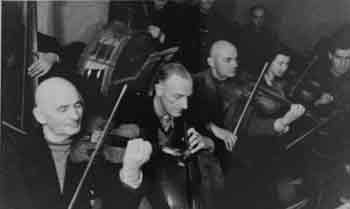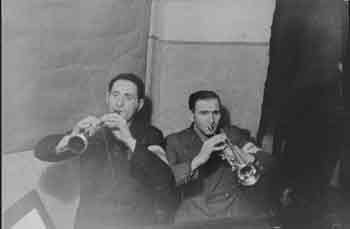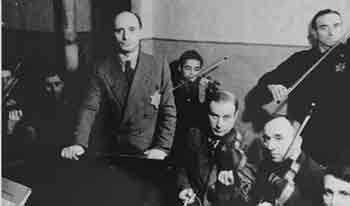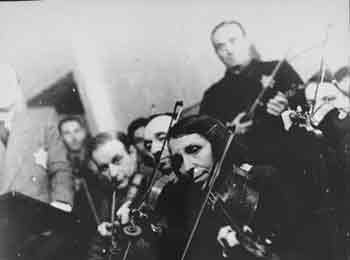The Kovno Ghetto Orchestra
Following the German occupation of Kaunas, many of the city's leading musicians, were forced to move to the Jewish ghetto. Most brought their musical instruments with them. However, on August 18, 1941, soon after the sealing of the ghetto, the Germans held a special "Intellectuals Action" which resulted in the murder of 534 of the most educated men in the ghetto. Afterwards, most musicians were afraid to publicly declare themselves as professionals. The Jewish council decided the best way to protect these musicians was to make them policemen and issue them uniforms. During the summer of 1942, when the killing actions had stopped and the ghetto was in the midst of its "Quiet Period," the council felt it was safe to ask permission for the ghetto's musicians to regroup into an orchestra. The orchestra consisted of 35 instrumentalists and five vocalists led by the noted conductor Michael Leo Hofmekler and the concertmaster Alexander Stupel. Performances were held bi-weekly, and a total of 80 concerts were given during the ghetto's history. Performances were given in the ghetto's Police House, the former building of the Slobodka Yeshiva. They were coordinated by the ghetto's director of education and culture, the noted linguist Chaim Nachman Shapiro (who was also the son of Kovno's chief rabbi). Though the first concert, which began with a moment of silence followed by "Kol Nidre" (the opening hymn of the Yom Kippur service), featured only serious music, many in the ghetto felt it was unseemly to hold concerts in a place of mourning. They considered these concerts to be solely for the ghetto elite and a desecration of the yeshiva. However, despite these criticisms, most felt that the concerts served a useful purpose in raising the level of morale in the ghetto. Ironically, though the musicians were initially made policemen as a form of protection, during the "Police Action" of March 27, 1944, only the musicians were spared transfer to the Ninth Fort.
Among those pictured are: Mordechai Borstein (left), Kalrisky (middle), and Maya Gladstein (right). Bornstein and Gladstein both survived and moved to Israel, while Kalrisky perished. |
|
Among those pictured are: Yankele (the 13-year-old youth playing the violin at the back), Michael Hofmekler (standing at the left), Boris Stupel (sitting next to Hofmekler), Alexander (Shmaya) Stupel (standing at the top right). Boris Stupel survived Dachau and later immigrated to Australia. His brother, Alexander, perished in Dachau. |
Among those pictured are: Alexander (Shmaya) Stupel (front row, third from the right), a well-known German-Jewish violinist, and his brother Boris, standing behind the violinists. Boris Stupel survived Dachau and later immigrated to Australia. His brother, Alexander, perished in Dachau. |
Robert Hofmekler (1905-1994) was the son of Motel and Bertha (Blinder) Hofmekler (spelled variously as Hofmekleris and Gofmekler). He grew up in a highly musical Jewish family in Vilna, where his father was a well-known cello player. Robert had three siblings: Zelda, Michael (b. 1898) and Leo (or M. Leo, b. 1900). In the fall of 1920 the family fled from Vilna to Kovno. Michael was a gifted violinist, who was decorated by the Lithuanian president in 1932 for his cultural achievement in propagating Lithuanian folk music in performances, recordings and transcription. Leo served as the conductor of the Lithuanian state opera in the 1930s. After the Soviets occupied Lithuania in 1940 he was appointed music director and conductor of the National Radio Orchestra in Vilna. Robert emigrated to the U.S. in the fall of 1938. Following the German occupation of Lithuania in the summer of 1941, Leo, his wife and two children were forced into the Vilna ghetto, where they all perished in 1942 or 1943. Motel and Bertha and Michael and Zelda were forced into the Kovno ghetto. Motel played in the ghetto orchestra. He and Bertha perished in the ghetto early in 1944. Zelda’s husband, David Kovarsky, was dragged from his home and shot by Lithuanian nationalists during the early days of the German occupation of Kovno. Zelda and her daughter perished in an underground malina (bunker) during the final liquidation of the ghetto. Michael served as the conductor of the ghetto orchestra. He was probably deported to Stutthof during the liquidation of the ghetto and then transferred to Dachau or one of its satellite camps. In late April 1945 he was evacuated and ultimately was liberated in the vicinity of Landsberg, Bavaria. Robert, who was drafted into the U.S. Army in January 1941 and served in Europe with the 9th Infantry and 10th Armored Division, found his brother at the St. Ottilien displaced persons hospital camp in June 1945.
USHMM
 Yerachmiel Wolfberg and Yitzhak Borstein
Yerachmiel Wolfberg and Yitzhak Borstein



